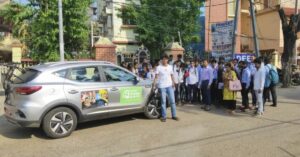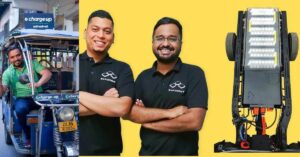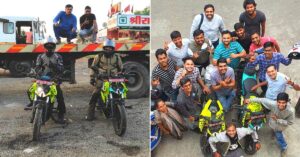How a Rickshaw Puller Inspired IIT-Kanpur Grad to Manufacture India’s 1st E-Rickshaw
In 2011, Vijay Kapoor, a 1972 IIT-Kanpur graduate, founded Saera Electric Auto Private Limited (SEAPL), an e-mobility venture. In the following year, he manufactured the company’s first batch of Mayuri e-rickshaws.

In the summer of 2010, Vijay Kapoor, an entrepreneur, was taking a ride on a cycle rickshaw in the bustling Chandni Chowk bazaar in New Delhi. During this trip, Vijay noticed the intense effort it took for the rickshaw puller to navigate through the crowded lanes of Chandni Chowk, which wasn’t commensurate with the money he was getting paid to ferry passengers.
(Above image of the first Mayuri e-rickshaw model)
Given his decades-long experience as an entrepreneur selling components to an Indian automobile manufacturer, he wanted to develop a product which would make the lives of rickshaw pullers easier.
“Speaking to these rickshaw pullers in Chandni Chowk and Sadar Bazar, I got a sense of the miserable conditions they were working under given the extreme weather and the intense physical labour required. Seeing their condition, I thought we should do something for them,” says the 73-year-old Vijay Kapoor, in a conversation with The Better India.
Around this period, Vijay had also travelled to China, where he saw a very crude model of the loader. Taking back the motor used in that model, he returned to India, and designed an e-rickshaw “taking into account the comfort of Indian passengers and drivers like the height at which a person has to get on the rickshaw (about 12 inches)”.
He designed all the necessary elements of an e-rickshaw, including the front glass “as per the requirements of Indian riders, especially the rickshaw puller, who shouldn’t have to expend all this effort, while also remaining eco-friendly and operating at a low running cost.” says Vijay.
Later that year, the IIT-Kanpur graduate founded Saera Electric Auto Private Limited (SEAPL), an e-mobility venture. In 2012, he manufactured the company’s first batch of Mayuri e-rickshaws. Some consider him the ‘Father of the E-Rickshaw’, but more accurately what Vijay did was pioneer the large-scale manufacturing of e-rickshaws in India.
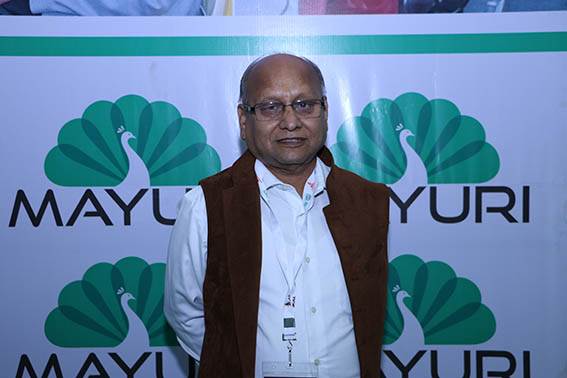
Past is prologue
Significant feats in engineering are achieved based on developments in the past. While Vijay did pioneer the manufacturing of e-rickshaws, it was another IIT-Kanpur alumni who built the first one.
Dr Anil Kumar Rajvanshi is the man credited for having developed the electric rickshaw in 2000 working out of the Nimbkar Agricultural Research Institute (NARI) in Phaltan, Satara district of Maharashtra. He was awarded the Padma Shri earlier this year.
Despite some initial interest, no one took the step of buying their design of e-rickshaws from NARI and commercialising it, he notes in his book ‘Romance of Innovations’. It would take a couple of more years before an entrepreneur like Vijay took the next step.
Graduating from IIT-Kanpur in 1972, Vijay got into the business of agriculture in Punjab.
“Initially, we were importing combine harvester machines from Germany and custom hiring them in Punjab. Due to the anti-Sikh riots and the subsequent troubles in Punjab in the 1980s, I moved to Delhi where I began manufacturing parts for the combine harvester machines, which I then started to export. During this period, I also came into contact with suppliers to Maruti. I had many friends from IIT-Kanpur, who were working there at the time,” recalls Vijay.
He recalls learning a lot about the automotive business. That experience would play a pivotal role in his bid to manufacture and sell e-rickshaws in India.
“In 2011, we started with a very simple model, which took us about one and a half years to develop. Initially, there was no infrastructure available to make or operate e-rickshaws. For example, nobody was ready to make tires for e-rickshaws, so we had to develop our own. There were no vendors in India making e-rickshaw batteries. We had to impart some technical knowledge to third-party vendors showing them how to assemble a battery pack and charger. Today, the infrastructure to manufacture an e-rickshaw is available,” notes Vijay.
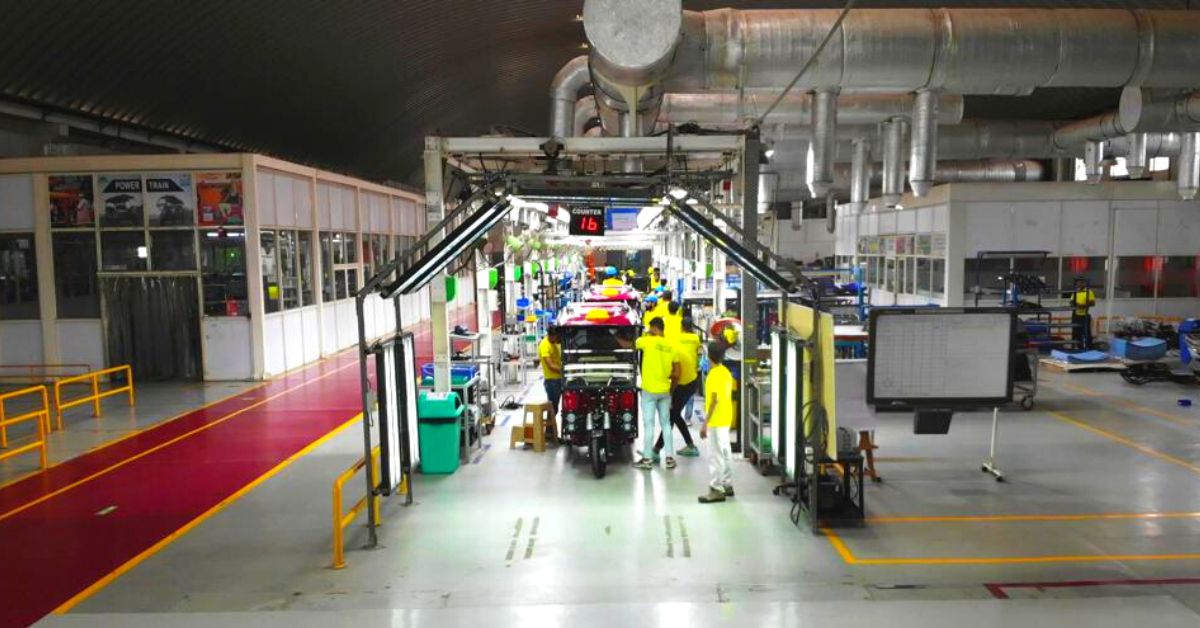
Building an e-mobility ecosystem
Starting out, the batteries available at the time weren’t fit for use in e-rickshaws because. In terms of design, they were completely different and not suited to use for e-rickshaws.
“We started with 35 AH lead acid batteries, which gave us about 30-40 km on a single charge with a charging time of 8 hours. Today, our e-rickshaws employ 130 Amp lithium-ion batteries with a charging time of only two hours, which gives us a 100 km range on a single charge. This improvement in battery range delivers a decent income to erstwhile rickshaw pullers who’ve made the transition to electric. Over time, we improved the battery design to suit our purposes. Our lithium-ion batteries today give us a three-year warranty, while the lead acid battery we first employed gave us only 1-year,” he recalls.
“Even for the axle, which we designed, we had to install very good bearings to ensure very less friction so that the vehicle gives us more kilometres. The biggest problem for the Indian market was when we made an e-rickshaw for two people, drivers were seating four people. When we made it for four people, they were seating six. We had to regularly redesign the main chassis. With the chassis available today, these e-rickshaws can carry bigger loads. There has been no breakdown of the chassis in our e-rickshaws now in the last two years,” he adds.
SEAPL even redesigned the tyres required for e-rickshaws, which today have a shelf life of 50-60K kms, while earlier it was only 2 months due to the different loads they were carrying.
The SAEPL e-rickshaws began with a 500W motor, while today they are using 1200W motors. With a 500W motor, the rickshaw struggled to climb up slopes. Also, SAEPL was importing the motor from China. Getting the vendor there to re-design it for Indian conditions was a tough process and the motor design went through 5 to 6 iterations before the one we currently employ.
“Another key factor was that the e-rickshaw should be economical for the rickshaw puller. What they earn is very important to me. That’s why we went for a 4 and 6-seater e-rickshaw so that they can make good money. Today, some of those who operate our e-rickshaws earn about Rs 1,200 to Rs 1,500 per day. Wear and tear is very less, while maintenance costs are minimal. They can just set aside Rs 100 every day to cover these costs,” he claims
To sell their first e-rickshaw, however, took about 8 months.
“Nobody was ready to buy one. I used to take my granddaughters to school in an e-rickshaw to advertise it. After 8 months, there was an old lady who purchased my e-rickshaw for her son but paid me only half the money. Later on, that lady would purchase 6 more e-rickshaws from me,” recalls Vijay.
But one of the biggest hurdles Vijay and SEAPL had to overcome at the time was the lack of rules and regulations for these e-rickshaws on the road.
“We cannot run any vehicle on our roads without clearance from the RTO (Road Transport Office) and rigorous testing from agencies like ICAT (International Centre for Automotive Technology). At the time, ICAT didn’t have any rules or regulations for electric Rickshaws ” he says.
There was eventually a committee formed by the Government of India under the chairmanship of Transport Minister Nitin Gadkari, which decided on all the norms including speed, amount of torque in the motors, and extra precautions required during the monsoon season to prevent water from entering the vehicle, what load amounts can they safely carry, etc.
All these tests are conducted by agencies by ICAT, but the rules and regulations are set by the government. “As industry stakeholders, we gave them our feedback. A bill to regularise e-rickshaws and provide for driving licences for battery-operated vehicles was introduced in Lok Sabha in December 2014 and subsequently passed by both houses. These rules and regulations were then passed on to the respective RTOs and these cleared up all the legal concerns. By the time these laws came into force, I had already sold more than 5,000 e-rickshaws. That was the biggest legal problem for me. It was eventually addressed with the passing of the Motor Vehicles Amendment Bill, 2014,” recalls Vijay.
When these rules were formally legalised, he increased production. Initially, Vijay had a small plant in Gurugram, which was making 20 vehicles per day. He then shifted base to a larger plant in Bhiwadi, Rajasthan, and today they are making about 170-200 e-rickshaws per day.
“Watching e-rickshaws on the road today gives me great happiness. It was a dream which came true. But before us, a large automobile manufacturer came with electric two-wheelers, which flopped. Anybody who bought their electric two-wheeler wasn’t eventually using it because they couldn’t service it. When we sold e-rickshaws, we also faced this problem,” he says.
But after having worked for nearly three decades in the automobile sector, he understood what was required. SEAPL primarily stressed servicing and availability of parts.
“In whichever areas my e-rickshaws were sold, we would train a mechanic in how to service them and ensure they were never short of spare parts. It was because of the prompt service that we succeeded. Unfortunately, the larger companies who had made the splash earlier didn’t take these elements into consideration when they manufactured electric two-wheelers,” he says.

The EV ecosystem has come a long way since then. Major markets in areas like Karol Bagh and Kashmere Gate have many shops today which have spare parts for electric vehicles. There are so many players who have entered the business in India, making parts for e-rickshaws.
Today, SEAPL is in the hands of his son Nitin Kapoor, and the Mayuri e-rickshaw ranks among the highest-selling brands in this category. Vijay, meanwhile, has moved into other spaces like hydroponics and is currently working on a “new project” despite his age.
Additional Sources:
‘E-rickshaw makers get a new charge’ by Mayank Dhingra; Published on 17 May 2017 courtesy Autocar Professional
‘History of Electric Rickshaws at NARI’ (Chapter from the book “Romance of Innovation”) by Anil K. Rajvanshi
‘The E-rickshaw story: Was the advent of electric mobility in India planned’ by Akshima Ghate, Dimpy Suneja; Published on 01 February 2018 courtesy The Energy and Resources Institute
(Edited by Yoshita Rao)
If you found our stories insightful, informative, or even just enjoyable, we invite you to consider making a voluntary payment to support the work we do at The Better India. Your contribution helps us continue producing quality content that educates, inspires, and drives positive change.
Choose one of the payment options below for your contribution-
By paying for the stories you value, you directly contribute to sustaining our efforts focused on making a difference in the world. Together, let’s ensure that impactful stories continue to be told and shared, enriching lives and communities alike.
Thank you for your support. Here are some frequently asked questions you might find helpful to know why you are contributing?


This story made me
-
97
-
121
-
89
-
167




